Today in the costuming series an 18th Century Provencal Caraco and Quilted Petticoat will be covered.
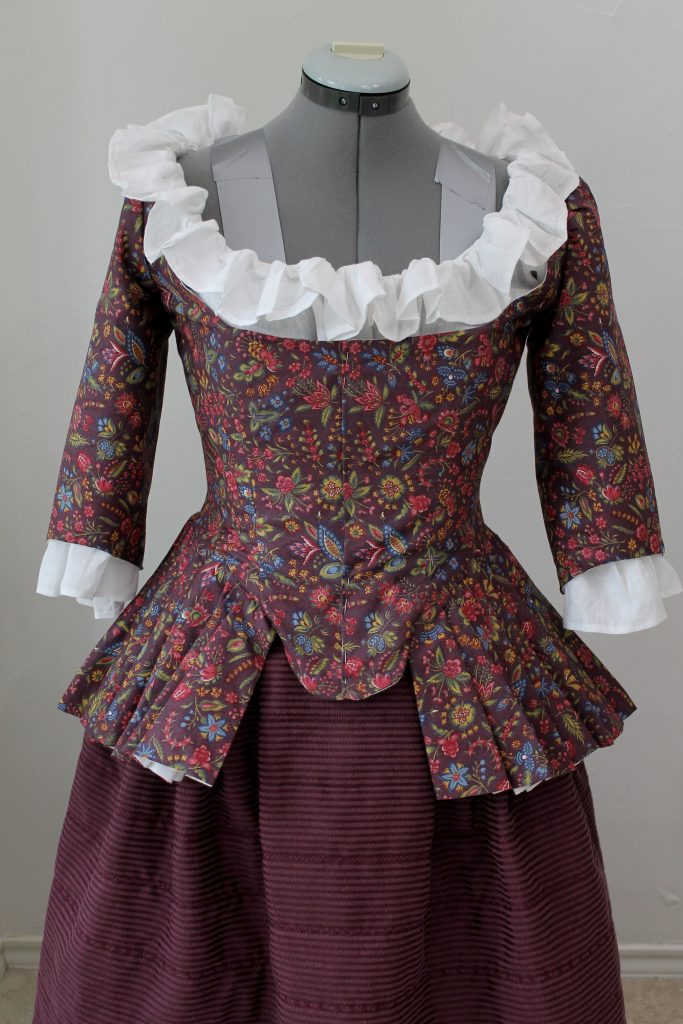
18th Century Provencal Caraco and Quilted Petticoat
As I mentioned in Mondays post the term petticoat was used to describe both an interior and exterior garment. We now separate the two garments into separate terms, the slip and skirt. Today I will share what an 18th-century woman would have worn as the last layer.

The Quilted Petticoat
The quilted petticoat came in such fabrics as cotton, linen, silk, and wool.
The interior batting used was generally cotton or wool.
Stitching styles could vary greatly. Generally when researching historical petticoats the more elaborate stitching indicates it was a garment of the very wealthy.
This simply stitched petticoat would probably have been worn by someone of the working class.

While this petticoat also features fairly simple stitching there is more of it. In addition, it is made from silk. It would have possibly been worn by a wealthier merchants wife or daughter.

Block-printed Indian cotton textiles, known as Indiennes, were imported into France during the second half of the 17th century. The fabric was quite fashionable during the late 18th century. It retained its popularity in the Provence region, where it was adapted and retained for use in regional costuming.
This petticoat features diamond stitching as well as narrow channels at the hem. The lighter color is also a good indicator that this petticoat was worn by someone of wealth.
The petticoats also were a way for ladies to publicly display their talents with the needle. This silk garment has about 7-8 quilting stitches per inch in the upper diamond pattern and features 13-15 quilting stitches per inch in the rosette and fan pattern in the border.
A garment such as this would have been months, if not years, in the making. I discussed the various symbols used in quilting that assist clothing experts of today in revealing many things about the wearer, and their family, HERE.

Inside Out
An average quilted petticoat would have three layers: the bottom fabric, middle quilt batting, and the top fabric.
Even good silk petticoats were generally lined with less expensive cotton or linen.
The lovely cobalt example above has two different cotton fabrics that were pieced together to create the backing fabric.
Making An 18th Century Petticoat
When I began looking at Pinterest on how to create a quilted petticoat I came up rather empty handed. There was one tutorial which was quite ingenious. The seamstress used a pre-quilted fabric bedspread to create her petticoat.
But I was seeking a more hands-on approach to my petticoat. So I took to studying construction details of antique petticoats.
This turkey red petticoat fabric features evenly spaced green and yellow sprigs. It is quilted all over in a small diamond pattern. The border at the hem is quilted with horizontal bands and undulating round puffs.

Turned inside out you can see that on this petticoat two different fabric patterns of printed calico were used. There is a brown cotton twill hem binding. The waistband appears to have cartridge pleating.
Making A Quilted Petticoat
A single fabric petticoat is actually quite easy to make. You don’t even need a pattern. I followed the measurement instructions and some of the sewing directions that I found in this tutorial.
The construction process was altered a bit since I was making a quilted petticoat.
- I first laid out the bottom fabric (a cotton sheet found at an estate sale for $3.)
- A layer of cotton batting was placed next. (I used a 50% off coupon so the cost was around $12.)
- The top fabric is placed on last. (My dear friend Dartanyan graciously gifted me this.)
- Safety pin all three fabrics together. This is so the fabric does not shift during the quilting process.
- Then it was time to start quilting. And quilting. And quilting. (It took me 3 hours to do the front part of the skirt and 2 hours to quilt the back of the skirt using a sewing machine.
- Strong 100% cotton quilting thread was found at Hobby Lobby. (Use a coupon, $1.50.)

In thinking about how the Provencal women tell their story through quilting stitches I decided to do the same. The bottom of the skirt has eleven rows of straight stitching set at a “4” length. This represents my wedding day April (4th month) 11th.
The waves represent Mr. Decor who was just accepted into the volunteer Coast Guard program.
The floral pattern is, of course, the Fashionista.
The running stitch symbolizes my cross country boy.
Lather, rinse, repeat.
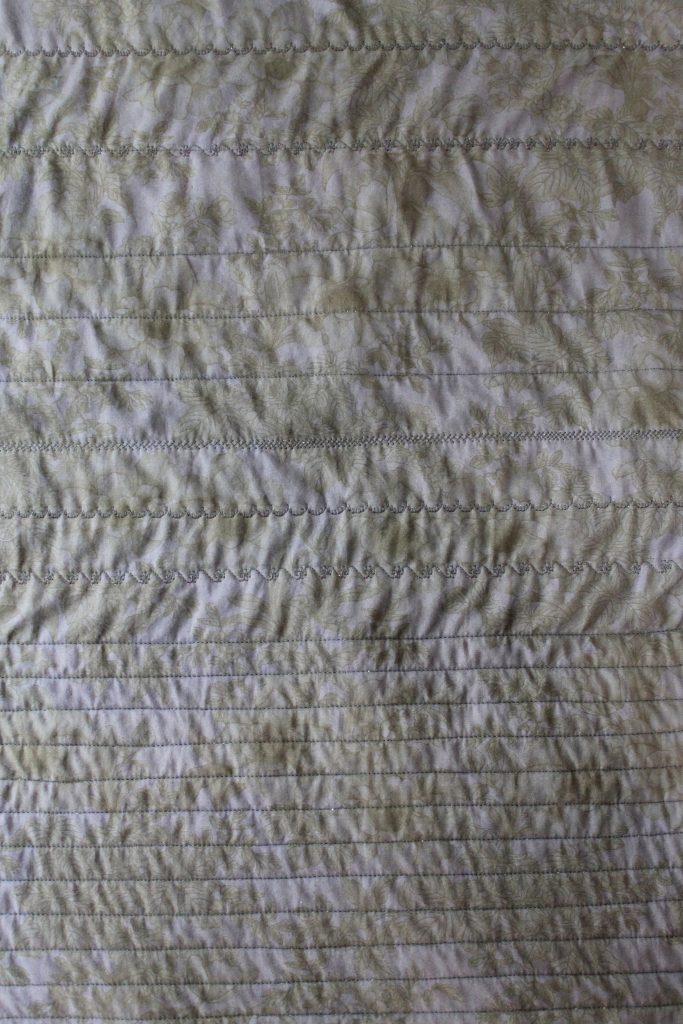
Petticoat Junction
Here’s the finished petticoat, inside out, on the mannequin. I love how women would historically add a bit beauty to areas of their garment no one would see. This handcrafted bit of antique lace is not quite straight so I would not use it on an outside garment but love the bit of pretty it adds to the waist.
The back of the petticoat is tied on first.
Then the front is tied closed. I thought you would like to see the side. Although it cannot be seen I do have access to a pocket worn underneath. You can read about 18th-century pockets HERE.
Making A Caraco Jacket
There were various styles of jackets worn by French ladies in the late 17th century. American Duchess does a grand job explaining the differences between a Caraco, pet en l’ier, Pierrot, and casaquin jacket.
During my visit to the Boutis Museum in France where I was allowed to examine 18th and 19th century Provencal jackets, Madame Francine referred to the sweet little creations featuring 3/4 length sleeves and short sassy peplums as caracos. In deference to her amazing talents and knowledge, I too shall refer to the jacket I created as a Caraco.
The Pattern
I selected pattern Butterick 3640. It is no longer in print so I purchased it from a long time reader and friend, Edie Marie. It can easily be found on eBay and Etsy. My intent was to make view “A”.

The fabric used is a historic reproduction of Dutch chintz fabric by Den Haan & Wagenmakers Beheer in Amsterdam. It is the “Les Petits Bouquet” pattern in the maroon colorway. I purchased it while I was in France. It was a splurge item for me at $28.00 a meter. I bought 2 meters. The fabric is a generous 56″ wide so I thought 2 meters would be enough for the pattern. I was wrong so I opted to just make a shorter peplum skirt on the jacket.
I made a plain white muslin first of the pattern before cutting into such fabric.
But the muslin did not go to waste. I do not like the look of unfinished seams so I opted to bag line the bodice.
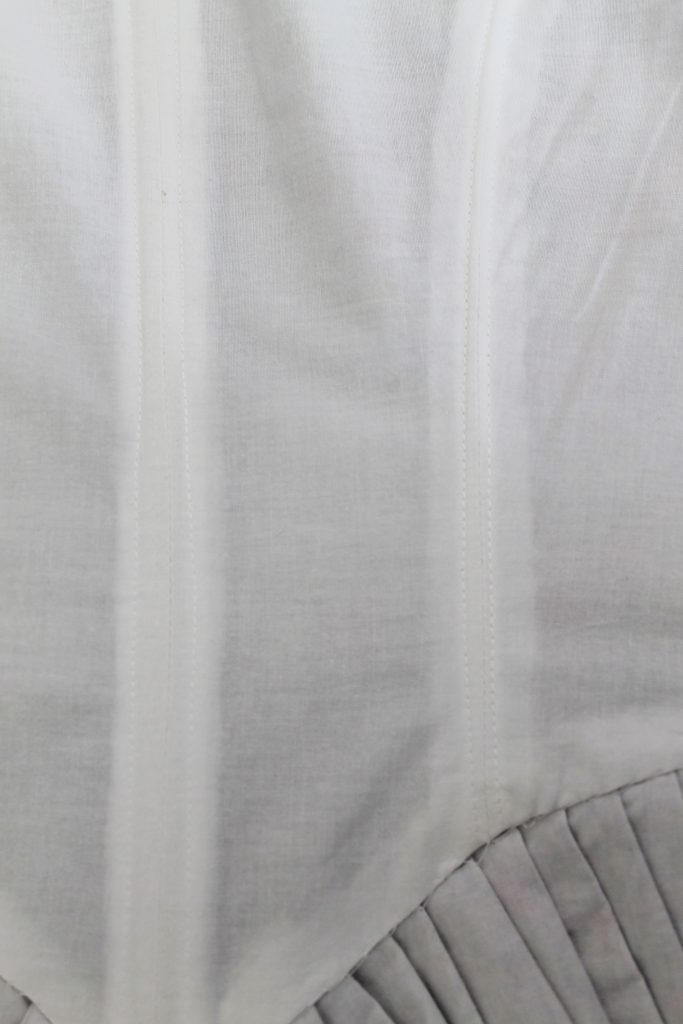
Historically Accurate?
I also opted to finish the armscyes (the area where the sleeve joins the bodice).
There’s an ongoing argument in the costuming community about whether or not this is historically accurate.
First off why argue about something so trivial? Work for world peace instead.
Second, everyone should do what they like.
Lastly, the extant jackets I viewed at the Boutis museum were constructed/finished in a variety of ways. It tickled me to no end when I saw a jacket which was made by a 18th-century woman who obviously didn’t like her seams to show either.

I LOVE the back of this jacket. I did NOT like all the pleating. Complaints were voiced during the construction process on my Instagram account.
When I become a better seamstress I will attempt pattern matching at the seams.
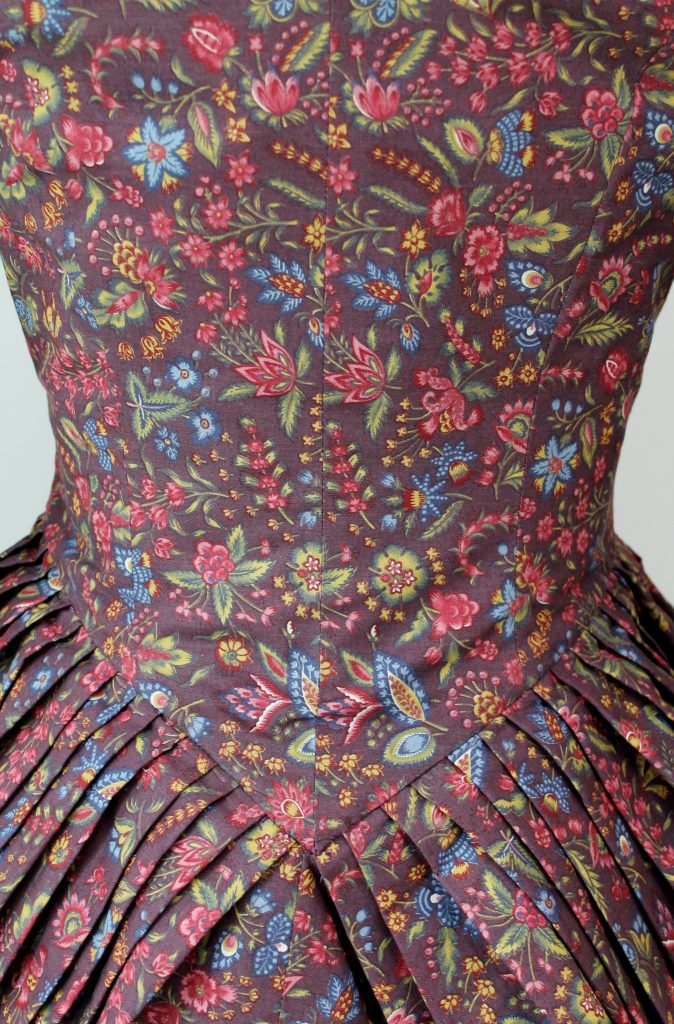
The front of the jacket is closed with straight pins which is shown at the top of the neckline. Further down is how the pins actually look because they are pushed into the boned stays worn underneath. The jacket did not move/open all afternoon.
Hooks and eyes would also be a historically accurate closure and I may add them at some point.

Cost
Petticoat: The exterior fabric was a gift. Interior fabric $3. Cotton batting $12. The binding for the hem and ties was $5. Thread $1.00 Total $21.00.
Caraco jacket: pattern $5. Exquisite authentic reproduction exterior fabric $56.00. Muslin fabric $2. Total $63.00
I’ll be back tomorrow with 18th Century Provencal Accessories.
Laura





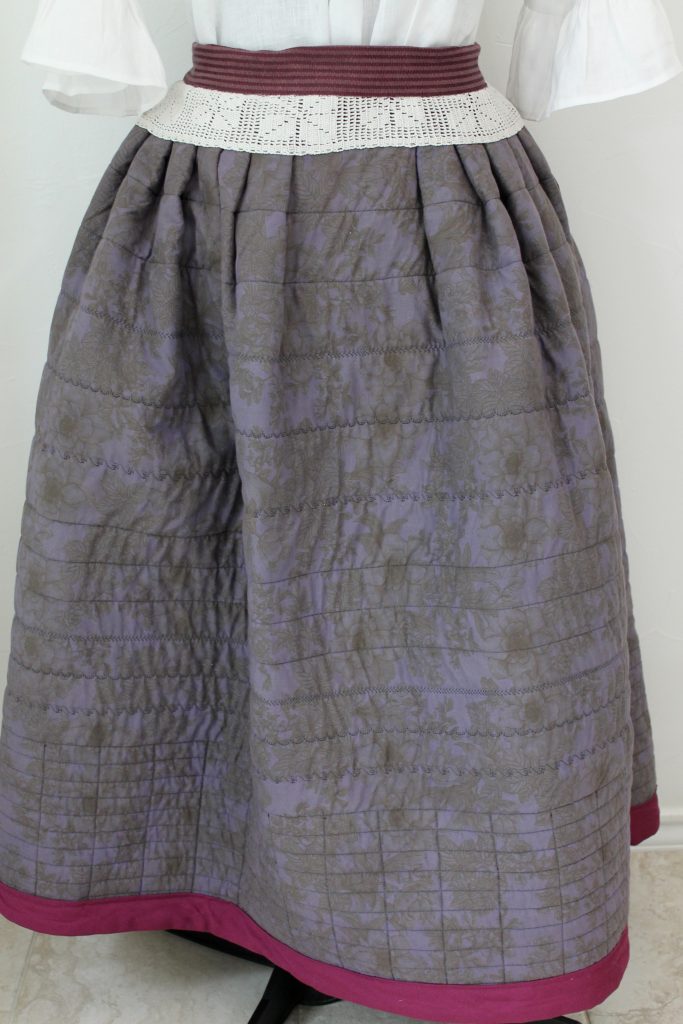
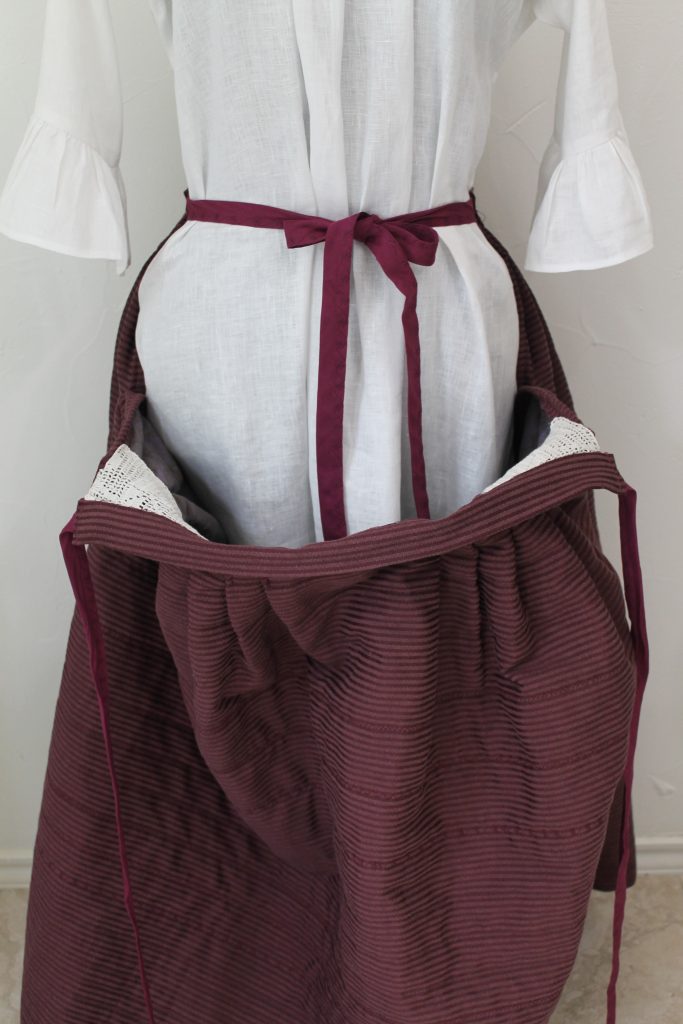
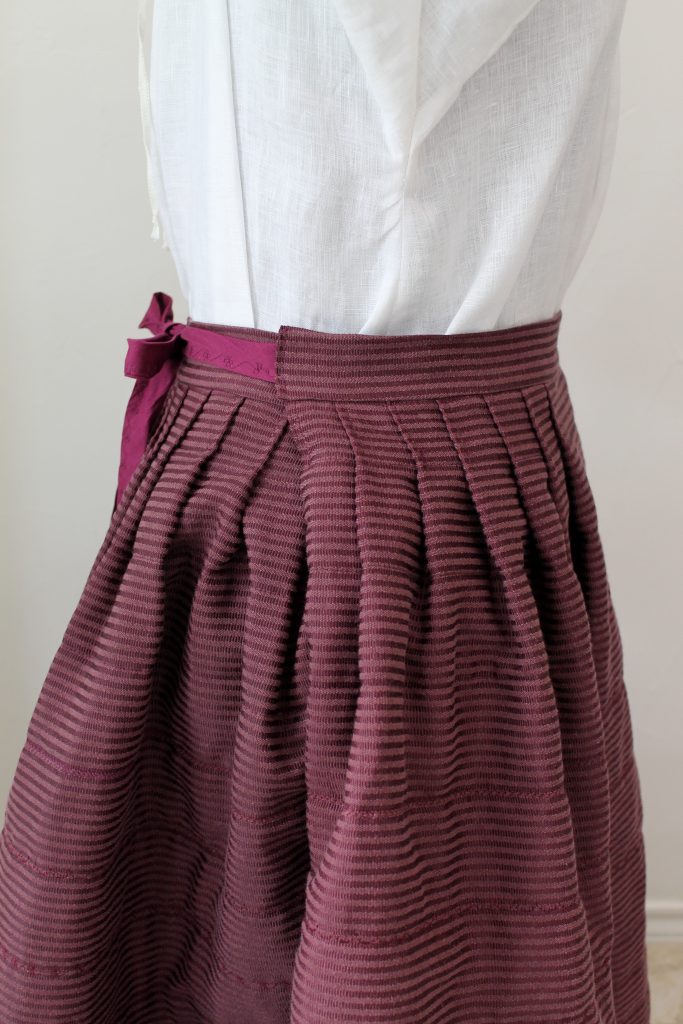
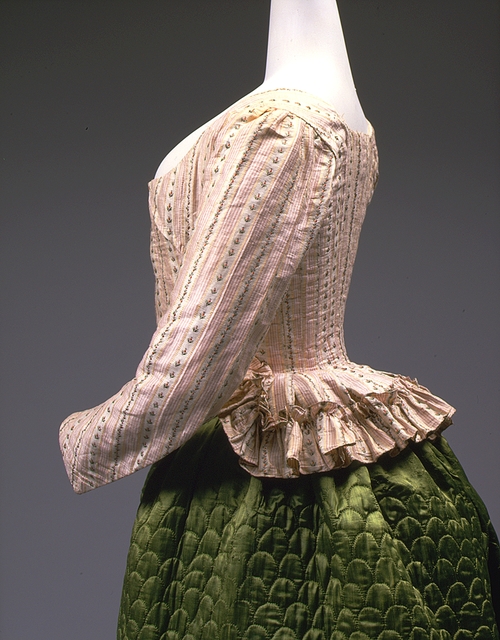
WOW and WOW and WOW! What a labor of love to make a quilted piece like that. Just GORGEOUS and SO labor intensive. I loved this post. Have a really great Wednesday- xo Diana
Oh my word, this is the most beautiful piece . I love all the quilting. Wow The jacket is amazing too. All those intricate details just blow my mind. You are an amazing seamstress.
What a gorgeous outfit you’re creating, Laura!
You are so amazing. I used to make all of my children’s clothing and some of my own, but as they became tweens/teenagers, that went by the wayside, of course. I haven’t really missed sewing much until I read your posts. Then I realize just how much I did not know and how much I left behind. I still make all my draperies and pillow covers and occasionally a skirt or pair of pull-on slacks, but I will live vicariously through you when I crave the real thing. Can’t wait to see the entire ensemble.
You are amazing! What a fascinating read!
Beautiful construction, Laura! I’m not on IG so I can’t read the complaints, but that’s probably a good thing – unbelievable!
I LIKE to sew, but I don’t love it. I can appreciate the work you did on all the pieces. They ALL came out lovely. And beauty is in the heart of the beholder. So the nay sayers can keep on making their seams match. 😉 For what it’s worth…..I couldn’t see the non matching seams from my house. lol Love this series. Thanks for sharing. Cindy
Oh Laura what an amazing post! I loved every word of it. And so sweet of you to mention me for the pattern. I have learned so much from your post. The petticoats are truly a work of art as is yours! I love adding special meaning to things I create and your special stitches for various reasons added a perfect touch. You created not just a costume but a meaningful work of art! I’m impressed beyond belief Laura!!
Blessings always! Edie Marie